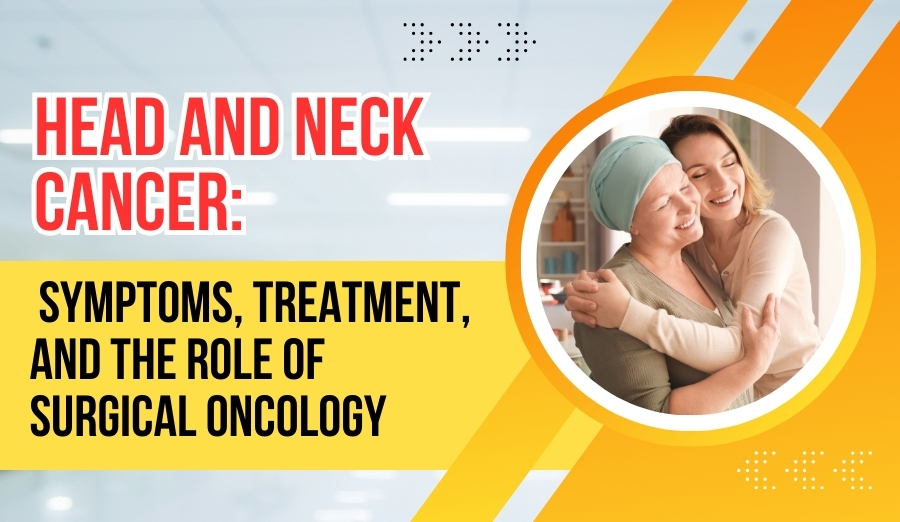-
BP Poddar Hospital
BP Poddar Hospital

Hello Reader!
Welcome to the blog page of Dr. Sunny Khanna, one of the best oncologist in Kolkata.
Head and neck cancers, which include malignancies in areas such as the mouth, throat, nasal passages, and salivary glands, represent a significant portion of cancer cases worldwide. Early detection and comprehensive treatment are key to improving outcomes. As one of the best oncologists in Kolkata, Dr. Sunny Khanna brings expertise and a patient-centered approach to managing these complex conditions. This blog explores the symptoms, treatment options, and the critical role of surgical oncology in addressing head and neck cancer.

Head and neck cancer encompasses a variety of cancers that originate in the squamous cells lining the mucosal surfaces of the head and neck. These cancers are often linked to risk factors such as:
Recognizing the early signs of head and neck cancer is crucial for timely diagnosis and treatment. Common symptoms include:
If you notice any of these symptoms, consult one of the best oncologists in Kolkata for a thorough evaluation.
Accurate diagnosis involves a combination of:
Treatment plans for head and neck cancer depend on the stage, location, and overall health of the patient. Common modalities include:
Also Read: How HIPEC improve survival Rates for Cancer Patients as per the best oncologist in Kolkata?

Surgical oncology plays a pivotal role in managing head and neck cancer, particularly in:
Dr. Sunny Khanna, recognized as one of the best oncologists in Kolkata, employs cutting-edge surgical techniques to ensure the best possible outcomes for patients.
Preventive measures significantly reduce the risk of head and neck cancer:
As one of the best oncologists in Kolkata, I, Dr. Sunny Khanna, am dedicated to staying at the forefront of advancements in surgical oncology, particularly concerning head and neck cancer. This field has seen remarkable innovations that enhance treatment efficacy, improve patient outcomes, and reduce recovery times. Here are some of the latest advancements shaping surgical oncology for head and neck cancer:
Transoral Robotic Surgery (TORS) has emerged as a groundbreaking technique in the management of head and neck tumors. This minimally invasive approach allows surgeons to access difficult-to-reach areas through the mouth, significantly reducing the need for external incisions. TORS offers several benefits:
Recent studies have shown promising outcomes with TORS for various tumors, including oropharyngeal cancers, indicating its expanding role in head and neck oncology.
Laparoscopic surgery is gaining traction in treating head and neck cancers due to its minimally invasive nature. This approach involves smaller incisions, leading to several advantages:
One of the significant advancements in surgical oncology for head and neck cancer is the development of microvascular free flap reconstruction techniques. This method allows for simultaneous tumor resection and reconstruction using tissue from other parts of the body. The benefits include:
Recent advancements emphasize organ preservation strategies that aim to treat tumors without removing entire organs. This approach is particularly beneficial for maintaining function while effectively managing cancer. Techniques include:
Nanotechnology is revolutionizing how we approach cancer treatment by enabling targeted drug delivery systems that minimize side effects on healthy cells. In head and neck cancer:

The most common risk factors for developing head and neck cancer include a combination of lifestyle choices, environmental exposures, and viral infections. Understanding these factors is crucial for prevention and early detection. Here are the primary risk factors associated with head and neck cancer:
Tobacco use is the most significant risk factor for head and neck cancer. This includes:
Excessive alcohol consumption is another major risk factor. The combination of alcohol and tobacco use significantly amplifies the risk of developing head and neck cancers. Studies indicate that individuals who both smoke and drink have a much higher risk compared to those who engage in only one of these behaviors.
Certain strains of HPV, particularly HPV-16 and HPV-18, are strongly associated with oropharyngeal cancers. The incidence of HPV-related head and neck cancers has been rising, especially among younger individuals. HPV is often transmitted through sexual contact, including oral sex.
Head and neck cancers are more common in individuals over the age of 40, with the average age of diagnosis being around 60 years. Men are approximately three times more likely than women to develop these cancers, largely due to higher rates of tobacco and alcohol use among men.
Previous radiation therapy to the head and neck region can increase the risk of salivary gland cancer and other types of head and neck cancers. Additionally, exposure to ultraviolet (UV) radiation can lead to lip cancer.
Neglecting dental hygiene can elevate the risk of oral cavity cancers. Conditions such as periodontal disease can contribute to an increased likelihood of developing malignancies in the mouth.
Certain occupations that expose workers to harmful substances can increase cancer risk. This includes exposure to asbestos, wood dust, nickel alloys, and other chemicals.
In addition to HPV, other viral infections such as Epstein-Barr virus (EBV) have been linked to specific types of head and neck cancer, particularly nasopharyngeal carcinoma.
A diet low in fruits and vegetables has been associated with an increased risk of head and neck cancers. Conversely, diets high in salt-cured fish or meat may also contribute to this risk.
Family history can play a role in increasing susceptibility to head and neck cancers due to inherited genetic syndromes or shared lifestyle factors within families.

Yes, early detection of head and neck cancer can significantly improve the prognosis for patients. Research indicates that when head and neck cancers are identified at an early stage, patients experience better survival rates, reduced treatment intensity, and an overall improved quality of life. Here are some key points illustrating the importance of early detection:
Early-stage detection of head and neck cancers allows for more effective treatment options, which can lead to significantly higher survival rates. Patients diagnosed in the early stages of the disease often have a five-year survival rate that is considerably higher than those diagnosed at advanced stages. For instance, studies show that patients with localized head and neck cancer have a much better prognosis compared to those with metastatic disease.
When head and neck cancers are detected early, patients may require less aggressive treatment approaches. Early-stage cancers can often be treated with surgery alone or combined with radiation therapy, which may preserve more healthy tissue and function compared to treatments required for advanced-stage cancers, such as extensive surgery or chemotherapy.
Early detection not only improves survival but also enhances the quality of life for patients. Treatments for early-stage cancers tend to have fewer side effects and complications, allowing individuals to maintain their normal activities and enjoy a better quality of life during and after treatment.
The need for effective early detection methods is underscored by the fact that many head and neck cancers are diagnosed at advanced stages due to the subtlety of initial symptoms. Increased awareness among healthcare providers and the public about risk factors—such as tobacco use, alcohol consumption, and HPV infection—can lead to more proactive screening efforts.
Advancements in diagnostic technologies, including imaging techniques and biomarker research, are improving the ability to detect head and neck cancers at earlier stages. For example, novel serological tests that measure specific biomarkers associated with head and neck cancer are being developed to enhance early diagnosis.
As one of the best oncologists in Kolkata, I provide personalized care, combining advanced surgical expertise with compassion. My approach ensures:

1. What are the common symptoms of head and neck cancer?
Symptoms include persistent sore throat, difficulty swallowing, voice changes, unexplained weight loss, lumps in the neck, and ear pain.
2. How is head and neck cancer diagnosed?
Diagnosis involves physical examinations, imaging tests (CT, MRI, PET scans), biopsies, and endoscopy to assess the affected areas.
3. What are the treatment options for head and neck cancer?
Treatment includes surgery, radiation therapy, chemotherapy, targeted therapy, and immunotherapy, depending on the cancer’s stage and location.
4. What is the role of surgical oncology in head and neck cancer treatment?
Surgical oncology focuses on removing tumors, reconstructing affected areas, and improving functionality like speech and swallowing.
5. Can head and neck cancer be prevented?
Yes, by avoiding tobacco and alcohol, practicing good oral hygiene, getting vaccinated for HPV, and minimizing exposure to carcinogens.
Head and neck cancer is a challenging yet treatable condition, especially with early intervention and expert care. Surgical oncology plays a crucial role in achieving successful outcomes, often in conjunction with other therapies.
If you or a loved one is facing symptoms of head and neck cancer, consult one of the best oncologists in Kolkata, Dr. Sunny Khanna. Together, we can work towards a healthier future with advanced, compassionate care.

January 30, 2025

January 29, 2025

January 28, 2025